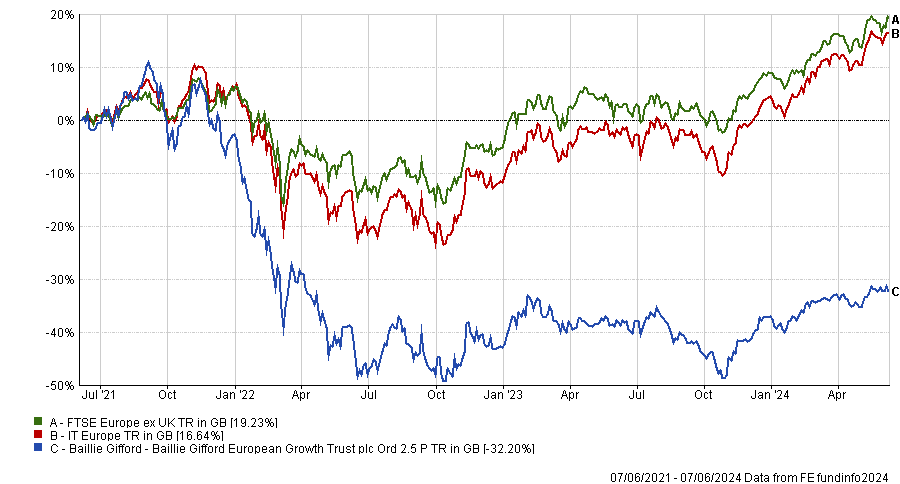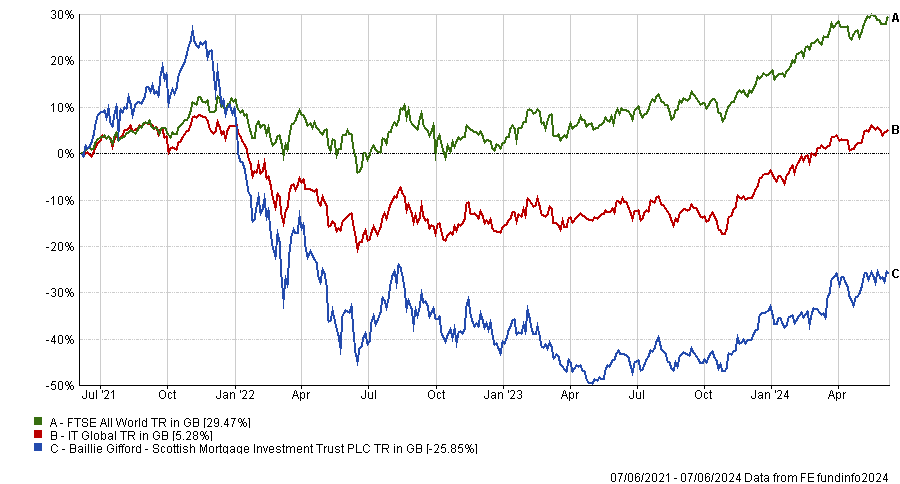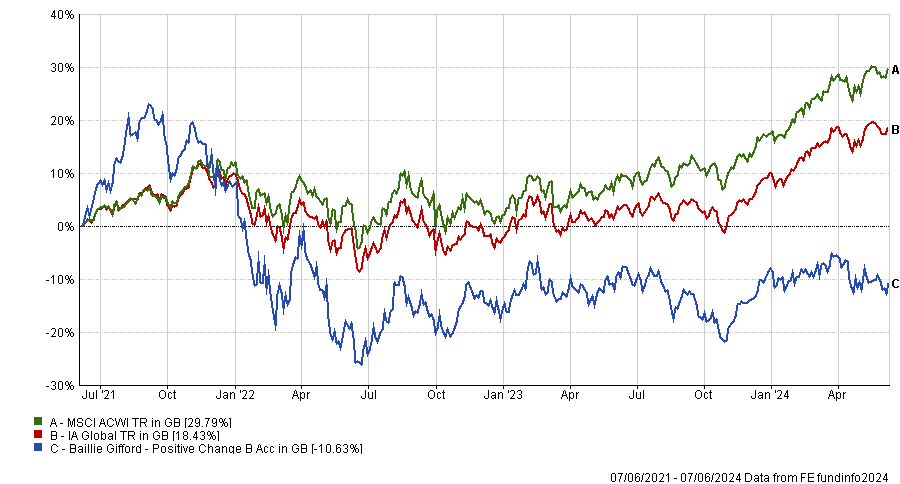Edinburgh-based Baillie Gifford has had a torrid time of late, with just one portfolio among its 46 funds and investment trusts making a top-quartile return in their respective sectors over the past three years.
The Schiehallion Fund was the only one to achieve the feat, despite making a 47.5% loss; most trusts in the IT Growth Capital sector plummeted even further.
Only two further portfolios beat their sectors, with the open-ended Baillie Gifford Responsible Global Equity Income fund and Baillie Gifford China Growth Trust making above-average returns in the IA Global Equity Income and IT China/Greater China sectors respectively. The latter, however, only has three constituents.
As a result, managers at the firm have admitted that mistakes were made over the past three years. Below they highlight key areas that have impacted performance.
Inflation and interest rates
One of the biggest impacts on Baillie Gifford’s growth-oriented suite of funds has been interest rates, which have rocketed in recent years to combat significantly higher than expected inflation.
Chris Davies, co-manager of the Baillie Gifford European Growth Trust, said this was a particularly big factor in Europe where inflation numbers hit double digits in some countries.
“If you go back to 2022, we went into that year with a portfolio that was probably set up to do much better in an environment where rates remained low. That was something we have been open about and was a mistake. We could have been more front-footed about that,” he said.
“There was some endemic inflation in the system anyway coming out of the pandemic but when Russia invaded Ukraine suddenly it just took off and, with that, interest rates moved up quickly, as did discount rates.”
Performance of trust vs sector over 3yrs

Source: FE Analytics
The trust’s overweight to mid- and small-caps, which today make up around 40% of the portfolio, got “whacked” and “hammered” during 2022, he admitted.
Lawrence Burns, deputy manager of the Scottish Mortgage Investment Trust, said if he had “more of an inkling” on the interest rate headwinds the trust faced, he would have made moves “at the margin” to limit losses, but the portfolio would still look broadly similar to today.
“We are investors in long-term growth companies. They are always going to come under pressure if there is a material rise in interest rates. But as we went through that period, we were quite clear that what we thought mattered in the long run was (more than interest rates) does the business work and succeed,” he said.
Burns admitted there were some factors the team could have looked at more, such as companies with greater capital requirements or more debt, noting they could have been “more attuned” and “a bit more alert” that the macro environment was changing.
Performance of trust vs sector over 3yrs

Source: FE Analytics
China
Another area that hampered Scottish Mortgage’s returns was China, with the market taking a battering over the past few years on the back on geopolitical concerns. The MSCI China index, for example, is down 34.8% over the past three years.
“If we’d incorporated some of the geopolitical tensions and the change in the domestic regulatory environment that was largely kicked off around the ANT attempted IPO, we probably would have [implemented] a higher bar for Chinese holdings sooner,” said Burns.
Since then, the trust has reduced its Chinese equity exposure to 10% from 25%, although the deputy manager noted that he is still “very happy to own companies in China”.
Stock selection
For Baillie Gifford Positive Change, two factors (as well as those mentioned above) have hit returns. The first is an underweight to the Magnificent Seven.
Rosie Rankin, investment specialist on the fund, said: “What has been particularly unhelpful for the relative performance of Positive Change over the past six to 12 months has been the incredible performance we have seen from a very concentrated number of stocks – the Magnificent Seven – to which we have a very low exposure indeed.”
Performance of fund vs sector over 3yrs
Source: FE Analytics
Another is the “execution risk”, she added, with some companies failing to match the ambition of their management teams.
Instead, the managers have “learned lessons” from the past few years particularly around risk and the “financial resilience” of stocks within the portfolio.
“We have a broad range of companies from steady growth compounding stocks like Deere with a long track record but then new innovative companies too. We want that balance,” she said.
Future headwinds
Lastly, Burns said he and lead manager Tom Slater have been looking ahead for potential headwinds and highlighted artificial intelligence (AI) as one area where investors can expect to see some volatility.
“There will be future headwinds. It will not be plain sailing for us for the next 20 years. At some point there may be an air pocket in AI demand. There has been a huge investment in AI hardware but whether that matches with demand as people work out how to use them at scale [remains to be seen],” the Scottish Mortgage manager said.
“Others include geopolitical tensions and what that means around the world. We have considered new potential holdings [and asked] what do we want in a more volatile world? Ultimately we are trying to own and back companies that are best placed to navigate that future.”





